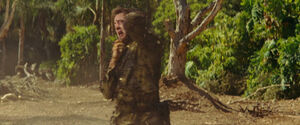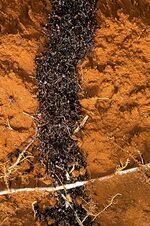- "Siafu. Big damn ants. Run!"
- ―Indiana Jones[src]

Siafu devouring their prey.
Siafu, also known as driver ants, army ants, giant ants, or giant ants of the Amazon[1] are giant red ants.[2] They are typically six inches long, with their size and appearance varying as a result of the quantity of fungus they are fed as larvae. Their jaws are strong enough to break human skin,[1] and a swarm was capable of carrying a full-grown human back to their nest.[2] The giants primarily served to retaliate against attackers.[1]
Adventures With Siafu
In 1957, while Indiana Jones and his comrades were trying to flee from the men following Irina Spalko in the jungles of Peru, the car containing Spalko, and Russian Driver, crashed into an anthill, containing a giant colony of the siafu. Seeing the ants swarming the car, the two fled, but while Spalko got to safety in a nearby tree, the ants swarmed the driver, and he was pulled down and dragged into the nest, where he was devoured alive. However, this affair agitated the ants, and a vast swarm of then now began raiding the forest floor. Soon, while Jones and the russian colonel Antonin Dovchenko where having a fistfight, the swarm approached them, but Harold Oxley revealed the Crystal Skull of Akator before them, causing the aants to diverge, and create an empty patch for Dovchenko and Jones to fight on. Eventually, Jones got the upper hand by beating the head of Dovchenko with a wooden trunk, causing the dazed colonel to fall backwards, into the antswarm. Subsequently, the ants swarmed him, and he was as well, pulled into their nest and devoured. THe ants subsequently dispersed, allowing Jones and his companions to proceed.
Behind the scenes

Real siafu.
Siafu are actually native to parts of Africa and Asia, not Brazil, and are oversized in the film. Being an archaeologist and not an entomologist, it's possible that Indy simply identified them incorrectly.
Brazil does have a genre of ants close to the Siafu, from the Atta genus (known locally as "Saúva").
